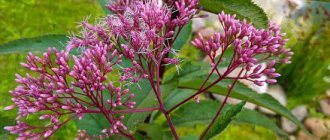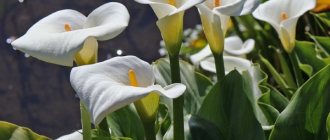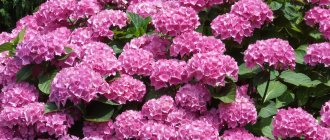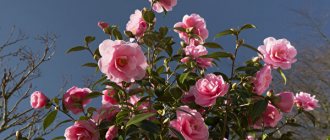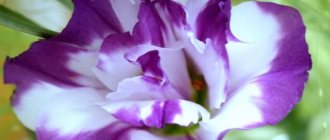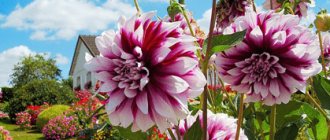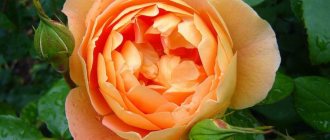Lychnis is a perennial decorative flowering shrub, popularly nicknamed “Adonis” for its bright, rich color. According to another version, the name refers to one of the varieties, the stems of which in ancient times were used as a wick for lamps and icon lamps. The second unofficial name is “soap plant,” given to it for the ability of the petals to become soapy when rubbed with your hands. It has been cultivated since the 16th century; currently, Lychnis is grown in the open ground of garden plots throughout almost the entire territory of Russia. It has many decorative varieties and hydrides.
Description of Lychnis: varieties and varieties
Adonis, Zorka are popular names for Lychnis, which very accurately convey the main feature of this flower. Lychnis is immediately noticeable in any flower bed: the bright flower simply catches the eye. Lychnis stems are straight, from 30 cm to 1 m high, depending on the plant variety, of an unusual ash color with a few lance-shaped leaves. The inflorescences are usually white, pink or red.
Lychnis flowering
The flowering of the perennial lasts about a month, and if you remove dried flowers in time, you can extend this period by several more weeks. Another feature of the plant is its soapiness (the rhizome and petals can become soapy), which is why Lychnis is popularly also called “Tatar soap” or “soap plant”.
Lychnis, planting and caring for it are not particularly difficult, so the flower is recommended as one of the first to be grown by inexperienced gardeners.
The genus Lychnis contains more than 30 species of plants, both annual and perennial, but 10 species are most widely used in landscape design, including Lychnis crown, Chalcedony, Alpine, and Viscaria.
Chalcedony Lychnis is a perennial up to 1 meter high with a straight stem. The leaves are oval or lanceolate-shaped, dotted with tiny hairs. The flowers are small (up to 1 cm), united in inflorescences in the form of a cap, white, red or pink.
Lychnis Chalcedonian
Crown Lychnis is a perennial with densely branched stems of a dark ash-gray color. Reaches a height of 80-90 cm. Blooms in late spring - early summer and blooms until late autumn. The inflorescences are racemose pink, white or bright crimson. The inflorescences are solitary, arranged quite densely on the stems. The most commonly found in open ground are “Angela Blanche” (a bush with large crimson-crimson, white, dark pink inflorescences), “Mysterious Island” (the flowers have white edges, the core is pinkish).
Lychnis crown
Unlike the two previous species, alpine lychnis is a low (up to 20 cm) shrub, often used in landscape design when decorating rocky hills and rockeries. This type of lychnis is quite easy to plant and care for, but it should be remembered that it is intolerant of acidic soil. Propagated by seeds. In open ground gardening, the Lara variety with soft pink inflorescences is grown.
Lychnis alpine
Lychnis Viscaria grows up to one meter in height and is distinguished by the special shade of its stems - they are purple. The inflorescence is paniculate in shape with crystal white, bright crimson or pinkish petals. Blooms in spring (late May) and blooms throughout June and July. Growing Lychnis Viscaria is recommended on loose, moist soils. The “Rosetta” variety with bright crimson double inflorescences looks impressive in the photo.
Lychnis viscaria
Lychnis Haage is a compact bush, grows up to 40-50 cm, bred by breeders as a garden hybrid. It is distinguished by bright red or bright orange inflorescences collected in brushes. The petals of the “Scorched Lava” variety are painted in bright bloody tones.
Lychnis haage
Lychnis Jupiter forms loose bushes, the height of the stems is about 80 cm, pubescent with white hairs. The inflorescences are light purple. It is advisable to rejuvenate the bush every 4 years.
Lychnis of Jupiter
Interesting varieties
In the garden you can plant natural or decorative varieties of viscaria:
- "Alba" Alba - this variety has decorative small white flowers, but sometimes not very showy.
- “Feuer” Feuer – the variety has light pink flowers.
- “Plena” Plena is a viscaria variety with double pink-purple flowers; due to the large number of petals, the calyxes of the plants often break.
- "Splendens" Splendens - shiny, carmine flowers.
- "Splendens Plena" Splendens Plena - one of the most popular varieties, has double, bright pink, shiny carmine flowers.
- “Alpina” Alpina - the variety is distinguished by large, numerous inflorescences with double flowers of intense purple and pink shades. Often used as an alternative to lawns planted in hard-to-reach places.
- “Pink Angel” is a variety with simple pink flowers.
- “Blue Angel” is a violet-blue variety of viscaria.
- “Nymph” – 50 cm high, a mixture with flowers of different colors. Blooms profusely from early June.
There are also multi-colored mixtures on sale, for example, viscaria "Holiday" - an annual 25 cm high in different colors.
Planting Lychnis
Successful cultivation of lychnis directly depends on the conditions for planting it in open ground and providing proper care. Lychnis can grow in partial shade, but its full potential is revealed when planted on the sunny side, then the inflorescences acquire greater volume, become more magnificent and brighter. Lychnis is frost-resistant and does not require shelter for wintering.
Attention: A perennial shrub can grow in one place for more than 5 years.
Suitable soil for lychnis is moist and contains sand (at the rate of 1 bucket of coarse sand per 1 square meter of area allocated for growing the plant). The soil must be loosened and well drained to avoid stagnation of water and death of the bush. About a month before planting lychnis, it is recommended to prepare the soil for it: dig up the soil while adding potassium magnesium (about 40 g per 1 square meter), superphosphate (50 g), 10 kg of humus (compost).
Plant Lychnis on the sunny side of the site
Botanical description
Lychnis is a herbaceous rhizomatous perennial plant from 40 to 100 cm in height with a straight, rounded stem covered with hairs. The leaves of Lychnis are lanceolate-ovate, acute, sometimes heart-shaped at the base, rough on both sides, semi-stem-encompassing. Bisexual flowers about 2 cm in diameter with dicotyledonous petals of bright red, pink, yellowish, white or bright orange colors are collected in terminal corymbs or heads. The fruit of Lychnis is a multi-nut with kidney-shaped dark brown seeds up to 2 mm in diameter, which remain viable for 3-4 years. Perennial Lychnis can grow in one place for up to 5 years.
Lychnis care
Lychnis, like many other perennials, is quite easy to care for. It is necessary to water it in moderation on time, mulch, fertilize, feed, cut off dried inflorescences and shoots.
Advice: do not flood the flower with water and allow the soil underneath to become waterlogged and moisture to stagnate in the open ground. Lychnis roots will begin to rot and the plant may die.
Watering lychnis should be moderate - as the soil dries out
In autumn, Lychnis should be pruned (all stems are almost at the root). There is no need to cover the perennial for the winter. Every 5 years the shrub needs to be replanted.
Requirements for planting site and soil
The species grows in a wide range of habitat conditions, prefers open and sunny places - dry meadows, hillsides, rocky and rocky areas, vineyards, slopes on railway tracks, wastelands, virgin lands, dry glades, forest edges. The settlement of slopes usually occurs on the southern, southeastern and southwestern sides. The species tolerates drought well; if drought occurs, the leaves quickly wither, but restore turgor and green color after rain.
Tar grows on various types of soils: poor, sandy, pebbly and rocky, usually neutral and acidic (sometimes defined as a species for acidic soils), on rocks, shale, less commonly on limestone and loam with a high content of calcium carbonate. In the northern part of its range, the species grows on limestone soils.
In the garden, viscaria is content with moderately fertile garden soil, provided that it is permeable. It grows poorly on heavy clay soils and freezes in winter due to too much water at the roots.
Fertilizer and feeding
Growing lychnis is not difficult, but you should provide the plant with the necessary minerals by applying mineral fertilizers 2-3 times during the growing season. The first time the perennial should be fed during the period of active growth, but before flowering begins, by preparing a solution of potassium sulfate, urea, superphosphate (take one tablespoon per bucket of water). Water the plant at the rate of 3 liters of solution per 1 square meter of area.
Feed Lychnis with mineral fertilizers
During flowering, a different solution is used for fertilizer, which includes superphosphate, potassium sulfate, and Agricola 7 - all in 1 tablespoon. Dilute in 10 liters of clean water and water, using up to 5 liters of fertilizer per square meter of lychnis growth. The perennial should be fed with the same solution in the fall after flowering has ended.
Growing and care
Viscaria is an extremely easy plant to grow and tolerates periods of short droughts well. Grows best in sunny and semi-shaded areas, permeable soil. It is very tolerant of soil fertility, although it prefers fertile and humus soils. Caring for viscaria is simple - just water it periodically; it does not need fertilizing.
Watering, fertilizing
Viscaria will withstand several days of drought. However, during flowering it needs more water. With a lack of water, it will quickly wither and significantly shorten the flowering period, but after watering it will come to life again. In extremely dry and poor soils the plant is unimpressive, but also blooms beautifully.
There is no need to feed viscaria, but when it is provided with fertile soil, it grows more luxuriantly and branches more. It can be fertilized from time to time, for example when fertilizing ornamental plants growing nearby.
You can also do without viscaria fertilizers altogether.
Wintering
Viscaria is relatively frost-resistant (resistant to frosts not lower than -25 ° C). However, on heavy clay soils it freezes in winter. In regions with more severe frosts it can freeze, so it requires shelter for the winter.
Diseases, pests
Sticky secretions of two-celled glands inside the inflorescences protect flowers from insects that steal pollen and nectar, but do not perform pollination.
Photo. An insect stuck to the sticky stem of a gum tree
Within one inflorescence, dozens of small insects adhere, including ants that steal nectar and protect aphids, thrips that feed on leaves and flowers. Viscaria is also attacked by nematodes, causing distortion of the leaves, and can become a victim of aphids or slugs that like its leaves.
Like a number of other perennials of the carnation family, viscaria can be infected by the fungus Microbotryum violaceum, which, without significantly affecting the viability of plants, leads to their sterility - fungal spores are released from the stamens instead of pollen and move between plants with the help of pollinators.
Viscaria can be affected by the following fungi: Thecaphora saponariae (in affected specimens the flowers are distorted and swollen), Pseudocercosporella woronowii and Ramularia didymarioides (spots appear on the attacked leaves).
In addition, viscaria leaves can become infected with powdery mildew, usually at the end of summer.
In the event of fungal diseases, the diseased parts of the plants must be removed, and the viscaria themselves must be sprayed with appropriate fungicides.
Plant propagation
Lychnis can be propagated vegetatively (by dividing the bush, cuttings) or by seeds.
- Propagation by seeds. Lychnis, unlike other shrubs, reproduces quite well by seeds that have excellent germination; some species and varieties can even reproduce by self-sowing. To grow lychnis from seeds, you need to sow them in open ground in the spring (April-May). The most suitable temperature for their germination is about 18-20°C, the time of emergence is 3 weeks after sowing. To improve the conditions for seed germination, you can cover the crops with film or agrofibre. After germination, the seedlings must be picked and planted in a permanent place. Lychnis grown from seeds in open ground will bloom no earlier than next year. More dense germination of seeds is possible with their stratification (change in temperature conditions).
- Propagation by cuttings is carried out in early summer. To do this, young shoots of the plant are cut up to 20-25 cm long, planted in a greenhouse or under film, wait for rooting and transplanted to a permanent place in early autumn.
- Reproduction by dividing the bush . The part containing young shoots is separated from the mother bush along with the rhizome and transplanted to a new location.
Lychnis seeds
Contraindications
Neoplasms, febrile conditions, systemic blood diseases, bleeding, active pulmonary tuberculosis, weeping eczema, circulatory failure of the 3rd degree. Exposure to the area where a pacemaker is implanted is contraindicated.
There was no evidence of any effect of Ultratonotherapy on the ability of patients to drive vehicles and operate machinery.
A perennial plant such as Lychnis is a member of the Clove family, but in some cases this genus is included in the Smolevka genus. The scientific name of such a plant comes from the Greek word, which translates as “lamp”. There is a version that this is due to the fact that Lychnis flowers have a very rich color or because in ancient times the foliage of one of the species was used as a wick. Mention of this flower can be found in the works of Theophrastus. It began to be cultivated from the end of the 16th century. According to information taken from various sources, this genus includes 20–50 species; in the wild they can be found in the Northern Hemisphere. Gardeners cultivate only 15 species of Lychnis.
Article on the topic: Prickly cocklebur - useful properties, description
Diseases and pests
Lychnis is rarely infected with diseases and pests, but with improper care it can be affected by spider mites, powdery mildew, aphids, and leaf rollers.
Growing a perennial in open, waterlogged soil can cause it to become infected with root rot, leaf spot, smut, and rust. It is recommended to ensure good drainage of the soil under the plant, constantly thin out the bushes, and the soil should be treated with copper-containing preparations before planting lychnis.
leaf roller
If a plant is infected with a leaf roller, it should be treated with biological products, for example, a solution of tobacco decoction or tomato tops. But in case of severe damage, it is necessary to use chemical insecticides (actara, intavir, karbofos). Treating lychnis with the indicated preparations by spraying before flowering begins will prevent further infection, but the plant will not bloom this season.
Selection of location and conditions of detention
Lychnis is an unpretentious plant that can grow and bloom almost anywhere. Suitable for growing in single and group plantings. In addition, Zorka is actively cultivated as a potted flower.
Lighting and location
Zorka can grow both in well-lit flower beds and in partial shade. For comfortable growth, short, diffused light is required. At midday, it is advisable to organize darkening - this avoids burns on the leaves. Lychnis is suitable for planting next to a structure or fence. Low-growing varieties are recommended for growing on alpine hills and rockeries.
Temperature
The plant is frost-resistant and drought-resistant. Can tolerate sudden changes in temperature and does not die due to frost. The optimal temperature range during the growing season is 15-25 oC. In winter it goes into a dormant stage; it is necessary to cover the flower bed and prepare for the cold.
Air and humidity
The flower prefers moderate air humidity. In waterlogged soil, the roots begin to rot, which leads to the death of the plant. Planting in lowlands and near bodies of water should be avoided. Can tolerate short-term drought; spraying is not required in hot weather.
Tall varieties have a stem that is sensitive to strong gusts of wind. It breaks easily and becomes deformed under strong impact. It is advisable to install a support or plant Lychnis next to the building. When growing Zorka in a pot, it is not recommended to keep it near a constantly opening window.
Priming
The soil for lychnis should be light and breathable. The planting site is preferably with loamy, sandy loam or sandy soil type. Waterlogged and waterlogged flower beds with high acidity and alkalinity should be avoided.
Lychnis can be grown in a pot. A large container with a diameter of 20 cm or more is suitable. Low-growing varieties can be grown in a general container with a height and width of 15 cm. The material of the pot does not affect the health of the bush, but it is best to choose ceramics or dense plastic in light colors.
Lychnis in landscape design
Lychnis in landscape design is used in flower beds, group plantings, and mixborders. It is good for rocky hills and rockeries. Lichnis is also used in the design of the banks of decorative garden ponds and lakes. Tall perennials can be used for summer decoration of fences, walls, gazebos (combined, for example, with clematis).
Lychnis in landscape design
This plant is mainly planted to add certain color accents, add brightness to the flower garden, and concentrate attention on bright spots. Lychnis alpine is used in rock gardens in sunny areas; it is also used to decorate stone flower walls. It is especially effective in group plantings among yellow flowers.
Lychnis is bright in bouquets when cut, but, unfortunately, it does not last long. Therefore, grow it in plots, decorate stone walls, plant it in a flower garden and rock garden and admire the vibrant colors of this flower.
Selection and preparation of planting material
Seeds can be planted directly in open ground. Planting is carried out from mid-April to the end of May, when the air and soil warm up to a stable temperature in the range of 8-12 ° C.
Lychnis planting material is quite large; before sowing it should be sorted and rejected. It is recommended to carry out stratification; to do this, they are placed in a damp cloth and put in the refrigerator for 2 weeks. To speed up the appearance of sprouts, seeds are soaked in warm water or a growth stimulant solution for 4-6 hours before sowing. After this they need to be dried.
Possible problems in growing
As a rule, problems in growing Lychnis crownata arise due to inattentive care and the introduction of infections into the soil. The bush especially suffers due to waterlogging of the soil.
Pests
The plant is often infested by parasites that feed on the sap of the bush. Among them are:
- leaf roller Sucks juices from shoots and leaf blades, which is why they begin to dry out;
- aphid. Eats leaves, causing them to dry out and fall off;
- spider mite It creates a web and stops the growth of the bush.
At the earliest stages of the spread of pests, they can be completely removed with a simple folk remedy - a solution of soap. But if a lot of damage is done, you need a stronger remedy - an insecticide for aphids and leaf rollers and an acaricide for spider mites.
Lychnis diseases
Diseases
Diseases affecting the bush:
- rust - the appearance of brown and yellow spots on the leaves;
- root rot - rotting of the root system and trunk;
- spotting - the appearance of dark spots on the leaves.
To combat diseases, you need to treat bushes with fungicides
Signs of improper care
If the care of lychnis is disturbed, then the bush will exhibit the following signs:
- rare or absent flowering. Occurs due to lack of lighting and oversaturation of fertilizers, especially nitrogen-containing ones;
- lack of growth and loss of brightness in stems, leaves and buds - lack of certain minerals in the soil, especially iron;
- rotting of roots and stems. The reason is freezing of the bush or excessive watering.
general characteristics
This beauty belongs to the large family of biennial plants, Cloveaceae, which came from Southern Europe. The short-lived perennial has silver-gray felt leaves and small spray-like flowers perched on long stems.
With proper care, Lychnis crown provides a colorful display of white, pink, and bright crimson until autumn. Recently, two-color and hybrid ones with terry have appeared. The genus name Lychnis is taken from the Greek lychnos for "lamp", referring to its historical use of leaves as a lamp wick.
Disembarkation rules
Appropriate place
The flower loves illuminated areas; most of its species also prefer moderately moist nutrient soil. If the soil is too wet, the plant's roots may begin to rot. It is best if there is short-term diffused light at the site where the lychnis is planted.
Optimal timing
Lychnis reproduces well by seeds. They need to be sown in open ground before winter or in spring, when the temperature is around + 20 degrees - in any case, Lychnis will bloom only next season. Although there are rare cases when it begins to bloom this summer. If propagation of lychnis is carried out by seedlings, then you will see flowers in the summer.
Selection and preparation of planting material
Seed material is obtained from flowers that produce “nuts” with seeds. They are stored in cloth bags or cardboard boxes. They can lie in cool and dark conditions for 4 years without losing the ability to sprout.
Instructions
The seeds are deepened one and a half centimeters into the ground. By covering the bed with film, you will get the first shoots in two to three weeks. When the third leaf appears, the seedlings are ready to “move” to their permanent place. However, it is worth noting that this method is not suitable for terry plant species.
For northern regions, propagation by seedlings is more suitable. To plant it in March, you need to get sprouts in advance. It is recommended to stratify the seeds, that is, put them in the refrigerator for 15–30 days. After planting in the ground, they are given a comfortable temperature, that is, +20 C, and the soil is slightly moistened. Otherwise, caring for it is the same as when planting seeds in open ground.
After a few weeks, the first shoots appear. The seedlings are hardened off for two weeks, and at the end of May they are placed in open ground.
When cuttings, shoots of an adult plant are taken at the beginning of summer. Specimens approximately 15 cm long are used. It is recommended to treat the cutting areas with crushed coal. After placing the cutting in the ground, water it.
When dividing a shrub, shoots are taken that appear annually from the root of each plant. If you dig up a bush in late spring and cut it in half with a shovel, each half can take root on its own. After placing them in the ground, parts of the bush need to be watered.
Easy to care for, Lychnis has no special maintenance requirements. However, if you want to get beautiful flowers, then you should follow some recommendations from experienced gardeners.
Lighting
As we noted above, Lychnis loves light very much, so “sunbathing” has an extremely positive effect on its appearance. It blooms more luxuriantly and abundantly when located in a illuminated area. The patient plant is able to withstand fluctuating temperatures, as it has good drought and frost resistance. During the growing season it feels best at temperatures from +15 to + 25 degrees.
The soil
The flower loves light soils with good drainage. Coarse sand on the site will also not interfere with this plant. It is best not just to dig up the soil before adding seed or seedlings, but also to fertilize it. To do this, take up to 10 kg of compost, 50 grams of superphosphate, 40 grams of potassium magnesia per square meter.
Watering
Stagnation of water has an extremely negative effect on the condition of lychnis. It is watered only in dry weather, which does not give way to cloudy weather for a long time. Sometimes it is enough to spray the bushes with water.
It is enough to fertilize good soil a couple of times per season, but poor soil can be saturated with useful substances monthly.
Loosening and mulching
The plant needs to loosen the soil. It is recommended to do this after every rain, as well as after watering. It is best to carry out the procedure in the morning. Mulching also helps to preserve soil properties. Without weeding, weeds can quickly colonize the area, thereby leaving it without food.
Trimming
If you remove dried buds in a timely manner, flowering will last longer. They need to be pruned; this procedure will provoke the formation of new inflorescences. Before the onset of winter, the above-ground part of the plant is cut off.
Wintering
Lychnis survives winter calmly, so there is no need to protect it from frost. In harsh climates, it is enough to sprinkle the area with leaves or branches so that the roots are sure to retain their vitality until the next season. The exception is the more capricious terry varieties - they must always be covered.
Transfer
Since Lychnis is unpretentious, it easily survives transplantation and division.
It is important to note that it is recommended to divide the bushes in the off-season, and to replant the flower with an earthen lump - from the beginning of regrowth until autumn, even during the set of buds and flowering
